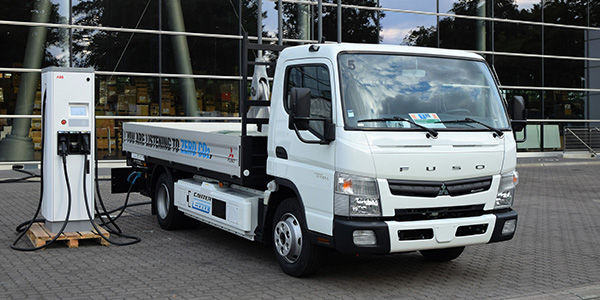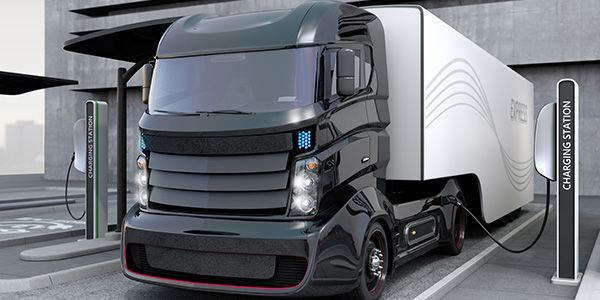Although there's an argument to be made on whether EVs work for commercial electric trucks, the idea is good. Who wouldn't want a powerful, quiet engine that pulls the same as a diesel and accelerates quickly? It's like a dream come true, and why didn't anyone think of this before.
Well, they did. It was 1906, and their name was Daimler. According to Daimler-Mercedes, "the first Mercedes electric car, the "Electrique," could be seen on the roads in Austria at the turn of the twentieth century." And when you think about it, that statement alone is truly remarkable since there wasn't an Elon Musk.
But then comes this statement, "However, electric drive systems could not compete with the internal combustion engine in terms of power and range."
Let's time-machine 115 years to 2021. Regardless of what the government would desire, it's still clear that, in their current form, electric drive systems can't compete with an ICE system when it comes to power and range.
Even Daimler's Freightliner EV Class 8 is promoted as a regional delivery vehicle. Although rated at up to 300 miles on a charge, that's only in-cab form since no one knows how long it may go when loaded with a fully packed trailer or two. Estimates are that it could be as low as 150 miles.
But we're getting ahead of ourselves. There's good with the bad, and even though 115 years hasn't changed anything, there are applications where EVs can work. Let's look at those first.
 WHY EVs CAN WORK
WHY EVs CAN WORK
TOTAL COST OF OWNERSHIP (TCO)
Let's assume you have the need and money to replace an in-service International diesel that's had decades of service. You decide on and purchase one of International Trucks local delivery EMV's.
As a fleet manager or owner, you can expect savings over your everyday ownership costs compared to comparable gasoline or diesel version - maybe. Ford, for instance, predicts a 40 percent drop in TCO with its new E-Transit, since this vehicle is primarily for those who have a 74 mile a day territory.
The other benefit is that starting at $45,000, it doesn't have a high barrier to entry. Nor does it require an infrastructure to support it other than the one already around at passenger charging stations.
EV POWER
Noise- No one enjoys the sound of a dump truck accelerating and decelerating through the neighborhood in the morning. So, that alone should be worth some good PR with the community. But the lack of vibration, harshness, noise, and exposure to fumes truly benefits the driver. In addition, at the end of a long shift, an operator will be less tired than in a diesel tractor.
ONE PEDAL OPERATION- Assisting in the ease of use is an EVs one-pedal operation. As found in Tesla's and most EVs, drivers can press the accelerator to move off from a stop and lift to come to a gradual halt. In addition, an EV activates the brakes to regenerate power and can be adjusted to stop more quickly or more gradually. Thus, the days of using the left foot to shift and the brake will effectively be gone in most situations.
ACCELERATION- While we're on the subject of taking off from a stop, there's the issue of immediate torque. Elon Musk has made a lot of noise about the Tesla Semi power, but as a reminder, let's look at some specs:
TESLA SEMI
- 0-60 mph in 5 seconds with the tractor cab only
- 0-60 mph in 20 seconds with an 80,000 lb. load
DIESEL SEMI
- 0-60 mph in 15 seconds with the tractor cab only
- 0-60 mph in 60 seconds with an 80,000 lb. load
Now, you could argue that we don't need an 80,000 lb. rocket but think of the lack of frustration in getting up to speed for freeway entrances and accelerating from stop lights.
IMAGE- Regardless of the initial cost of a commercial EV replacement, priceless marketing goodwill and promotion will come with an EV in your stable. Yes, the public will talk about your vehicle and name as you go about your work, but it may also open more avenues for work with government entities. We've quickly gotten to where a business is rewarded work if it can put "carbon neutral" or a "green company" on the bids.
WHY EVs WILL STRUGGLE
UPFRONT COSTS
Costs are continuing to come down in the passenger EV market. But, even there, models will have a 25-40 percent premium over a comparable ICE model. It's the same for commercial EVs.
Looking at the previously mentioned Ford E-Transit, the current starting price is $45,000, where a V6 version is $40,000. And if you want to forgo hanging out at the local Whole Foods while charging for an hour or two, you'll want to get a non-residential DC fast charger installed at the garage. That will cost you up to $40,000. Like babies, EVs come with the need for extras.
The item driving the higher price is a battery. And if you move up to Class 8 tractors, they use multiple batteries to power the loads, increasing costs exponentially. Additionally, larger commercial vehicles require more power and a substantial infrastructure cost of up to $100,000 to support them.
RANGE ANXIETY
Daimler-Mercedes admitted that range anxiety kept the original electric vehicle from competing against the internal combustion engine. And that's still an EVs biggest hurdle.
While purchasing an E-Transit for local work is a genuine possibility, it would be a hard sell to the Capital Expenditure team to justify a Class 8 electric truck that will only go 150 miles before it must be plugged in for a lengthy charge up.
Companies currently testing electric Class 8 trucks say that their diesel will make three round trips before refueling to every two round trips of an EV. And then, the EV will have an extended downtime for recharging while the diesel fills up and goes.
 BUT WAIT, THERE'S MORE
BUT WAIT, THERE'S MORE
Recent history shows that Flex-Alerts and shutdowns of electrical grids are becoming more commonplace in California and Texas. Yes, you can charge overnight, but what happens when the power isn't available, or you've moved up to a higher tier of costs because of your increased electrical needs. Being unable to go on a job because you have overloaded the lines isn't the best of scenarios.
Another thing to consider, if you have a large fleet, is training and support services for the EVs. Extra equipment to work to service EVs is causing some automotive dealerships to struggle with cost containment. Kit includes shock-resistant jumpsuits, high voltage protection, a plan to deal with battery fires - and increased liability insurance.
Regarding battery fires, Tesla says recommends pouring 3,000 gallons of water on a damaged battery pack to keep it from igniting. Unfortunately, that's more than you probably have around the garage.
THE FUTURE
The truth is that we're headed towards the inclusion of more EVs into our fleet. How many you purchase will be based on multiple factors such as use, operational footprint, and support infrastructure.
The benefits of commercial EV usage are apparent in the right circumstances. However, whether it's a clear choice for your business may need some more consideration.




